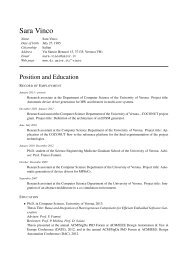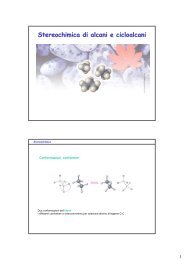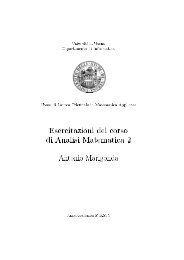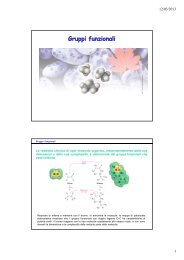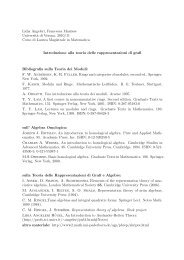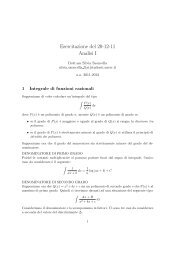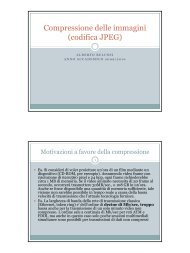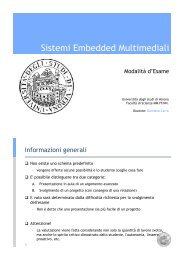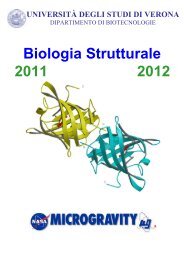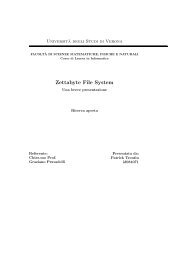Create successful ePaper yourself
Turn your PDF publications into a flip-book with our unique Google optimized e-Paper software.
92 19. INTEGRALI CURVILINEI, TEOREMA DI STOKES, FORMULE DI GAUSS-GREEN - CONTINUAZIONE<br />
Per stabilire se ˆn = ∇G = ((∇G)1, (∇G)2, (∇G)3) o ˆn = −∇G, è necessario verificare l’orientamento della<br />
superficie calcolando<br />
⎛<br />
∂φ1 ∂φ2 ∂φ3<br />
⎞<br />
⎜<br />
det ⎜<br />
⎝<br />
∂x<br />
∂φ1<br />
∂y<br />
∂x<br />
∂φ2<br />
∂y<br />
∂x<br />
∂φ3<br />
∂y<br />
⎟ ⎛<br />
⎟ 1<br />
⎟ = det ⎝ 0<br />
⎟ 2x<br />
⎠<br />
0<br />
1<br />
2y<br />
−2x<br />
−2y<br />
1<br />
⎞<br />
⎠ = 4y 2 + 4x 2 > 0<br />
(∇G)1 (∇G)2 (∇G)3<br />
Poiché il determinante è pos<strong>it</strong>ivo, si ha ˆn = ∇G(x, y) = (2x, 2y, 1). Calcoliamo ora il rotore di F .<br />
⎛<br />
⎞ ⎛<br />
i j k<br />
i j k<br />
rotF = det ⎝ ∂x ∂y ∂z ⎠ = det ⎝ ∂x<br />
y<br />
∂y ∂z<br />
2 ⎞<br />
0 x − y<br />
⎠ = (−1, −1, −2y)<br />
F1 F2 F3<br />
Pertanto per quanto riguarda il flusso richiesto si ha:<br />
<br />
<br />
<br />
rotF · ˆn dσ = (−1, −1, −2y) · (2x, 2y, 1) dxdy = −<br />
S<br />
Passando in coordinate polari, x = r cos θ, y = r sin θ, si ottiene:<br />
<br />
1 π/2<br />
rotF · ˆn dσ = − 2r(cos θ + 2 sin θ) r dθ dr = −<br />
S<br />
0<br />
Calcoliamo ora il flusso utilizzando il teorema di Stokes:<br />
<br />
<br />
rotF · ˆn dσ =<br />
0<br />
D<br />
S<br />
+∂S<br />
1<br />
0<br />
F dγ.<br />
2r 2 dr ·<br />
D<br />
π/2<br />
0<br />
2x + 4y dxdy<br />
(cos θ − 2 sin θ) dθ = 2<br />
3 .<br />
Parametrizziamo il bordo di D in senso antiorario: esso è dato da γ1(θ) = (cos θ, sin θ) per −π/2 < θ < 0,<br />
γ2(t) = (1 − t, 0) per 0 < t < 1 e γ3(s) = (0, −s) per 0 < s < 1. Il bordo di S orientato in senso pos<strong>it</strong>ivo sarà<br />
allora l’immagine delle tre curve γ1, γ2, γ3 mediante la parametrizzazione φ di S:<br />
Pertanto si avrà:<br />
dove:<br />
<br />
<br />
<br />
φ◦γ1<br />
φ◦γ2<br />
φ◦γ3<br />
F dγ =<br />
φ ◦ γ1(θ) = (cos θ, sin θ, 1 − cos 2 θ − sin 2 θ) = (cos θ, sin θ, 0);<br />
φ ◦ γ2(t) = (1 − t, 0, 1 − (1 − t) 2 ) = (1 − t, 0, 2t − t 2 );<br />
φ ◦ γ3(s) = (0, −s, 1 − s 2 ).<br />
=<br />
F dγ =<br />
F dγ =<br />
<br />
0<br />
+∂S<br />
−π/2<br />
π/2<br />
0<br />
w=cos θ<br />
= 1 −<br />
1<br />
0<br />
1<br />
0<br />
<br />
F dγ =<br />
φ◦γ1<br />
<br />
F dγ +<br />
φ◦γ2<br />
<br />
F dγ +<br />
φ◦γ3<br />
F dγ<br />
(sin 2 0<br />
θ, 0, cos θ − sin θ) · (− sin θ, cos θ, 0) dθ = −<br />
sin 3 θ dθ =<br />
0<br />
1<br />
π/2<br />
0<br />
−w 2 dw = 2<br />
3<br />
(0, 0, 1 − t) · (−1, 0, 2 − 2t) dt =<br />
(−s 2 , 0, s) · (0, −1, −2s) dt =<br />
Sommando i tre contributi si ottiene:<br />
<br />
<br />
rotF · ˆn dσ =<br />
S<br />
sin θ(1 − cos 2 θ) dθ = 1 −<br />
+∂S<br />
che verifica così il calcolo diretto svolto in precedenza.<br />
1<br />
0<br />
1<br />
0<br />
π/2<br />
0<br />
2(1 − t) 2 dt = 2<br />
3 .<br />
−2s 2 dt = − 2<br />
3 .<br />
F dγ = 2 2 2 2<br />
+ − =<br />
3 3 3 3 ,<br />
−π/2<br />
sin 3 θ dθ<br />
cos 2 θ sin θ dθ



